蚯蚓对农药代谢反应的荟萃分析:剂量-反应、时间趋势和途径扰动
IF 7.3
2区 环境科学与生态学
Q1 ENVIRONMENTAL SCIENCES
引用次数: 0
摘要
农用化学品通过破坏土壤栖息生物的基本生化途径,对土壤生态系统构成重大威胁,其中蚯蚓、关键的生态系统工程师和敏感的生物指标尤其脆弱。虽然传统的生态毒理学方法提供了有价值的有机体终点,但代谢组学提供了一种能够检测早期亚致死生化扰动的系统级方法。这项荟萃分析综合了截至2024年12月发表的符合条件的研究结果,以量化暴露于各种农用化学品的蚯蚓的代谢组学破坏。meta回归显示了显著的负剂量-反应关系(β = -0.45, 95% CI: -0.62至-0.28,p < 0.001),表明在较高的毒物浓度下代谢抑制加剧,而时间分析显示,随着暴露时间的增加,代谢抑制逐渐减弱(β = 0.023, 95% CI: 0.011-0.035, p < 0.001),表明毒性作用是累积的。毒物类别特异性反应差异很大,新烟碱类引起明显的代谢上调(log2FC: 2.48),而有机磷类引起强烈的代谢抑制(log2FC: -2.95)。途径水平分析显示,能量和氨基酸代谢的上调与碳水化合物和三羧酸(TCA)循环途径的下调一致,表明应激诱导的代谢转变。物种特异性差异也很明显,Eudrilus eugenae比模式物种Eisenia fetida具有更高的灵敏度(log2FC: -4.2)。尽管研究之间的异质性很高(I2 = 96%),但一致的代谢破坏趋势出现了,这加强了代谢组学在环境监测中的价值。这些发现强调了标准化方法的必要性,以提高可比性,并强调了代谢组学在提供生态毒理学风险评估的机制见解方面的潜力。本文章由计算机程序翻译,如有差异,请以英文原文为准。

Meta-Analysis of Metabolic Responses of Earthworms to Agrochemicals: Dose-Response, Temporal Trends, and Pathway Perturbations
Agrochemicals pose significant threats to soil ecosystems by disrupting essential biochemical pathways in soil dwelling organisms, with earthworms, key ecosystem engineers and sensitive bioindicators, being particularly vulnerable. While traditional ecotoxicological methods provide valuable organismal endpoints, metabolomics offers a systems level approach capable of detecting early, sublethal biochemical perturbations. This meta-analysis synthesizes findings from eligible studies published up to December 2024 to quantify metabolomic disruptions in earthworms exposed to various agrochemicals. Meta-regression revealed a significant inverse dose-response relationship (β = -0.45, 95% CI: -0.62 to -0.28, p < 0.001), indicating intensified metabolic suppression at higher toxicant concentrations, while temporal analysis demonstrated progressive disruption with increased exposure duration (β = 0.023, 95% CI: 0.011–0.035, p < 0.001), suggesting cumulative toxic effects. Toxicant class-specific responses varied substantially, with neonicotinoids eliciting pronounced metabolic upregulation (log2FC: 2.48) and organophosphates inducing strong metabolic suppression (log2FC: -2.95). Pathway-level analysis revealed a consistent pattern of upregulated energy and amino acid metabolism alongside downregulated carbohydrate and Tricarboxylic Acid (TCA) cycle pathways, indicating a stress-induced metabolic shift. Species-specific differences were also evident, with Eudrilus eugeniae displaying greater sensitivity (log2FC: -4.2) compared to the model species Eisenia fetida. Despite high heterogeneity among studies (I2 = 96%), consistent metabolic disruption trends emerged, reinforcing the value of metabolomics in environmental monitoring. These findings highlight the need for standardized methodologies to enhance comparability and underscore the potential of metabolomics in providing mechanistic insights for ecotoxicological risk assessment.
求助全文
通过发布文献求助,成功后即可免费获取论文全文。
去求助
来源期刊

Environmental Pollution
环境科学-环境科学
CiteScore
16.00
自引率
6.70%
发文量
2082
审稿时长
2.9 months
期刊介绍:
Environmental Pollution is an international peer-reviewed journal that publishes high-quality research papers and review articles covering all aspects of environmental pollution and its impacts on ecosystems and human health.
Subject areas include, but are not limited to:
• Sources and occurrences of pollutants that are clearly defined and measured in environmental compartments, food and food-related items, and human bodies;
• Interlinks between contaminant exposure and biological, ecological, and human health effects, including those of climate change;
• Contaminants of emerging concerns (including but not limited to antibiotic resistant microorganisms or genes, microplastics/nanoplastics, electronic wastes, light, and noise) and/or their biological, ecological, or human health effects;
• Laboratory and field studies on the remediation/mitigation of environmental pollution via new techniques and with clear links to biological, ecological, or human health effects;
• Modeling of pollution processes, patterns, or trends that is of clear environmental and/or human health interest;
• New techniques that measure and examine environmental occurrences, transport, behavior, and effects of pollutants within the environment or the laboratory, provided that they can be clearly used to address problems within regional or global environmental compartments.
 求助内容:
求助内容: 应助结果提醒方式:
应助结果提醒方式:


